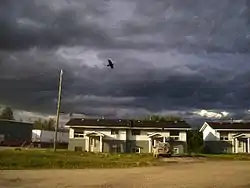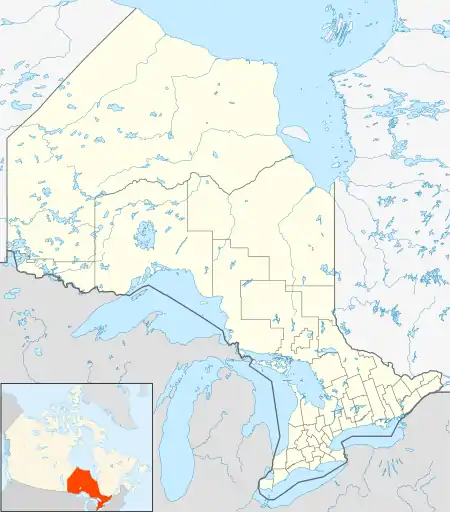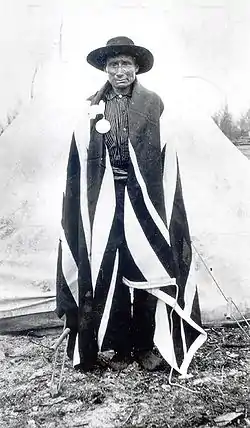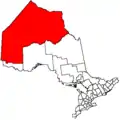Sandy Lake First Nation
Sandy Lake First Nation (or Negaw-zaaga'igan Nitam-Anishinaabe, Oji-Cree: ᓀᑲᣞ ᕌᑲᐦᐃᑲᐣ ᓂᑕᒼ ᐊᓂᔑᓈᐯ) is an independent Oji-Cree First Nations band government. The First Nations community, in the west part of Northern Ontario, is located in the Kenora District, 227 km (141 mi) northeast of Red Lake, Ontario. Its registered population in June 2007 was 2,474. As of December 2015 the total registered population reached 3,034. Sandy Lake First Nation maintains an affiliation with Nishnawbe Aski Nation, as a signatory to the Treaty 5.
Sandy Lake 88
ᓀᑲᣞ ᕌᑲᐦᐃᑲᓃᐣᐠ | |
|---|---|
| Sandy Lake Indian Reserve No. 88 | |
 | |
 Sandy Lake 88 | |
| Coordinates: 53°04′N 93°20′W | |
| Country | Canada |
| Province | Ontario |
| District | Kenora |
| First Nation | Sandy Lake |
| Government | |
| • Chief | Delores Kakegamic |
| • Deputy chief | Marcel Linklater |
| • Head councillor | Wayne Kakepetum |
| Area | |
| • Land | 45.69 km2 (17.64 sq mi) |
| Population (2011)[1] | |
| • Total | 1,861 |
| • Density | 40.7/km2 (105/sq mi) |
| Website | www.sandylake. firstnation.ca |
Sandy Lake is policed by the Nishnawbe-Aski Police Service, an Aboriginal-based service.
Reserve
The First Nation's land base is the 4,266 hectare (10541.47 acre) Sandy Lake 88 Reserve (Oji-Cree:ᓀᑲᣞ ᕌᑲᐦᐃᑲᓃᐣᐠ (Negaw-zaaga'iganiing). Within this reserve is the community of Sandy Lake, which during the mid-1900s was known as Waabitigweyaang (ᐙᐱᑎᑴᔮᐠ) which translates to White River. Associated with the community, the Sandy Lake First Nation maintains seven neighbourhoods grouped into five districts:
- Airport / Centre
- Big Rock / Ghost Point
- Old Sawmill
- River
- Roman Catholic
Sandy Lake is serviced by a Northern Store owned by the North West Company Inc. The community is a fly-in community, serviced by Wasaya, Superior and Perimeter Airlines, and is linked to the rest of the province by a winter ice road that travels southwest towards Deer Lake and Pikangikum, meeting Red Lake via the Nungesser Road, which is open for approximately six weeks during the winter months.
Sandy Lake's education is maintained by the Sandy Lake Board of Education, and is serviced by three schools: Thomas Fiddler Memorial Elementary School, Thomas Fiddler Memorial High School, and Washtennigun Christian School. There is also an operational Adult Learning Center, with ties to Confederation College and Lakehead University.
Clans
Five doodem are found at Sandy Lake First Nation; these five clans are the: Suckers, Pelicans, Crane, Caribou and Sturgeon.
Language

The Sandy Lake First Nation speaks the Oji-Cree language and uses a variant western Ojibwe Syllabics.
Sandy Lake Syllabics e i, ii o, oo a, aa Final ∅, ', h ᐁ ᐃ ᐅ ᔭ y ᐁ ᐃ ᐅ ᔭ ᣟ w ᐍ ᐏ ᐓ ᐘ ᣞ p, hp, f ᐯ ᐱ ᐳ ᐸ ᐦ t, ht, th ᑌ ᑎ ᑐ ᑕ ᐟ k, hk ᑫ (P) ᑭ (P) ᑯ (P) ᑲ (P) ᐩ or ᕽ c, hc ᒉ ᒋ ᒍ ᒐ ᐨ m ᒣ ᒥ ᒧ ᒪ ᒼ n ᓀ (P) ᓂ (P) ᓄ (P) ᓇ (P) ᐣ s, sh ᓭ (ᕋ) ᓯ (ᕈ) ᓱ (ᕍ) ᓴ (ᕊ) ᐢ hs, hsh ᐢᓭ (ᐢᕋ) ᐢᓯ (ᐢᕈ) ᐢᓱ (ᐢᕍ) ᐢᓴ (ᐢᕊ) ᐢ l ᓫᓀ (ᓫP) ᓫᓂ (ᓫP) ᓫᓄ (ᓫP) ᓫᓇ (ᓫP) ᓫ r ᕑᓀ (ᕑP) ᕑᓂ (ᕑP) ᕑᓄ (ᕑP) ᕑᓇ (ᕑP) ᕑ
Unlike most Syllabics orthographies, Sandy Lake Syllabics Orthography has some unique features:
- Merging of ᐁ-shape and ᔦ-shape sets, but no such merging reflected in the ᐍ-shape set;
- Final y and w written respectively as ᣟ and ᣞ, and not respectively as ᐩ and ᐤ;
- Sandy Lake Orthography is always written in the Unpointed Style, thus the Syllabics'...
- consonant's fortis and lenis values (other than for s and sh) are not distinguished, and
- vowel's length values are not distinguished;
- Although s [s] and sh [ʃ] are distinguished in speech, they are not in writing;
- Fortis s (hs) and fortis sh (hsh) in a word-internal position are written as a gemination;
- ᑫ-shape, ᓀ-shape, and ᓭ-shape sets can vary respectively as P-shape, P-shape, and ᕋ-shape sets;
- ᐦ (p) and either ᐩ (k\hk) or ᕽ (k\hk), and not ᐦ (h), ᐩ (y), and ᕽ (hk or nk);
- l and r are written as ᓫ and ᕑ nesting above the ᓀ-shape set.
(Note: In James Evans' original Syllabics design, ᣟ was the original designation for the Final y before it got replaced by ᐩ now used by most Western-style Syllabics users; this older form of Final y is still used by handful of northern Canadian communities, including Sandy Lake.)
Government
The Sandy Lake First Nation governed by an elected Chief, a Deputy Chief and (8) eight councillors. The current Chief is Delores Kakegamic, and the Deputy Chief is Marcel Linklater. The Head Councillor is Wayne Kakepetum; the other seven Councillors are John McKay, Allan Rae, Fabian Crowe, Russell Kakepetum, Dennis Kakegamic, Yvonne- Fiddler Kakekagumick, and Darren Meekis.
In addition to the Governance Council, the Sandy Lake First Nation maintains an Elder Council to advise the Governance Council. Working with the Governance Council, six boards carry out the Council's operations: Community Development Services, Education, Health, Housing, Radio Station, and Recreation.
Climate
Sandy Lake has a subarctic climate (Dfc) with severely cold winters and mild summers.
| Climate data for Sandy Lake | |||||||||||||
|---|---|---|---|---|---|---|---|---|---|---|---|---|---|
| Month | Jan | Feb | Mar | Apr | May | Jun | Jul | Aug | Sep | Oct | Nov | Dec | Year |
| Average high °C (°F) | −15 (5) |
−11 (12) |
−3 (27) |
7 (45) |
15 (59) |
21 (70) |
24 (75) |
23 (73) |
16 (61) |
7 (45) |
−4 (25) |
−13 (9) |
6 (42) |
| Average low °C (°F) | −26 (−15) |
−25 (−13) |
−17 (1) |
−7 (19) |
1 (34) |
8 (46) |
13 (55) |
12 (54) |
6 (43) |
−1 (30) |
−12 (10) |
−22 (−8) |
−6 (21) |
| Average precipitation mm (inches) | 20.6 (0.81) |
21.5 (0.85) |
24.3 (0.96) |
22.2 (0.87) |
49.0 (1.93) |
78.1 (3.07) |
97.0 (3.82) |
79.4 (3.13) |
67.1 (2.64) |
58.6 (2.31) |
33.9 (1.33) |
25.8 (1.02) |
577.5 (22.74) |
| Average precipitation days | 16 | 13 | 12 | 10 | 16 | 18 | 20 | 19 | 19 | 19 | 18 | 16 | 196 |
| Source: http://www.worldweatheronline.com/Sandy-Lake-weather-averages/Ontario/CA.aspx | |||||||||||||
Transportation
Sandy Lake Airport serves the community. Sandy Lake also has the ice/winter road during the winter months for people to drive in and out of the community. It starts at the end of Nungesser Road, goes through North Spirit Lake FN and next is the junction where the road splits into two, one going to Deer Lake FN and the other coming to Sandy Lake FN.
Notable people
References
- "Sandy Lake 88 census profile". 2011 Census of Population. Statistics Canada. Retrieved 20 June 2015.
